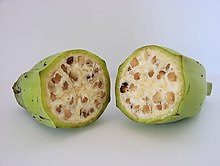Wild type

Wild type (or wildtype abbreviated wt) refers to the phenotype of the typical form of a species as it occurs in nature. Originally, the wild type was conceptualized as a product of the standard, "normal" allele at a locus, in contrast to that produced by a non-standard, "mutant" allele. It is now appreciated that most or all gene loci exist in a variety of allelic forms, which vary in frequency throughout the geographic range of a species, and that a uniform wild type does not exist. In general, however, the most prevalent allele[clarification needed] – e.g., the one with the highest gene frequency - is the one deemed as wild type.[1]
The concept of wild type is useful in some experimental organisms such as fruit flies Drosophila melanogaster, in which the standard phenotypes for features such as eye color or shape and wing form are known to be altered by particular gene mutations that produce distinctive phenotypes, such as "apricot" "bar eyes" or "vestigial wings." Wild-type alleles are indicated with a "+" superscript, for example B+ and vg+ for round eyes and full-size wings, respectively.
See also
References
- ^ Jones, Elizabeth; Hartl, Daniel L. (1998). Genetics: principles and analysis. Boston: Jones and Bartlett Publishers. ISBN 0-7637-0489-X.
{{cite book}}: CS1 maint: multiple names: authors list (link)
External links
- "Absence of the wild-type allele" - Pediatrics
- "Genetically-spliced bacteria may benefit agriculture" - Sarasota Herald-Tribune
- "Reading of DNA allows creation of synthetic vaccines" - Star News
- "A Curious Clue in Cats" - Newsday
- "A Genetically Engineered Agriculture Revolution?" - The Telegraph
